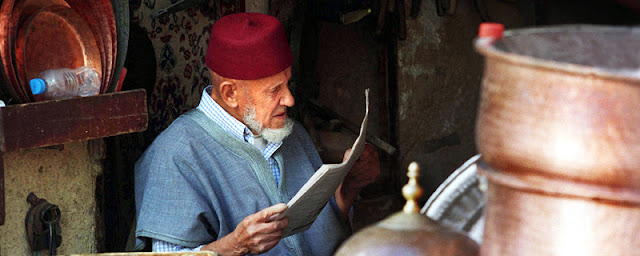Today’s guest author is Sally Lyall Grant, a seasoned traveller who recently spent six months living in Fes and studying Arabic. She says studying Arabic is as hard as getting to know Fes – both take up a good deal of time and energy! Sally first travelled to Morocco many years ago and has visited the country on numerous occasions. At present Sally is back in London contemplating her next step. She is not a regular blogger but The View from Fez feels she should be.
 |
| The Medina of Fez |
I have just spent 6+ months living in Fes, Morocco seeking to discover the mysteriously elusive language, culture and architecture of this World Heritage site. Visiting one hidden mausoleum with some local friends and a foreigner who has lived in Fes more than five years, I was surprised to hear the English guy didn’t even know it existed, let alone visited it. Muslim and more specifically Moroccan architecture is designed to prevent prying eyes seeing into the interior of houses. Tall walls and small windows well above ground level are the norm. Most tourists, who typically spend only 3 days in arguably Morocco’s most interesting city, see only the souks, tanneries, museums and medersas (ancient Islamic colleges). It is so difficult to see what lies behind the walls! Mosques are also out of bounds to non-Muslims but Muslim travellers would probably be welcomed at any one of the 350 or so mosques in the old medina.
The medina is the heart of Fes and consists of a maze of extremely narrow streets called derbs. Very few derbs are named and there are no accurate maps which is all part of the fun of independent exploration! Behind the walls, there is a surprising amount of greenery in Fes, from small riad gardens to extensive ones. One of my favourites is the Jardin des Biens where you can sit and chill out over a drink in beautiful surroundings. You can also have a meal or a traditional hammam (public bath) there as well. It can be daunting for some, however, to find their way around and visitors only staying a short time are often advised to take a guide. My advice would be to stay as long as you can in Fes as every day you will discover something new and meet wonderful people who are only too happy to share their town with you.
 |
| Fez Cafe Jardin des Biehn |
Many of Fes’ palaces, dars (large town houses) and riads (houses with courtyard gardens) have been turned into hotels and, although it sounds strange, visiting hotels is very rewarding and something not many people have the chance to do. It is one way of penetrating the walls. Many are beautifully restored riads and the owners or their employees are happy to show them off. Carpet shops and expensive restaurants are also set in beautiful surroundings but I would counsel avoiding these as the carpet shops are as hard-sell as ‘time share’ and the expensive restaurants tend only to be for tourists and some are barely better than you would get elsewhere for less than half the price. At street level near Bab Boujeloud, I liked old favourites the Kasbah for couscous and Thami’s for brochettes (kebabs). But I didn’t eat out much as I lived with a Moroccan family who made delicious food!
 |
| traditional couscous |
But what about the nightlife you might ask? Well, there are lively cafes doubling as music venues selling mint tea, coffee and soft drinks (and sometimes alcohol). The most famous of these is the Cafe Clock, a magnet for travellers, but I preferred the lesser known Scorpion du Desert, a Berber cafe tucked away between the two main medina streets. I also liked a little no-name cafe with only two tables run by a partially sighted man deep in the medina.
 |
| Scorpion du Desert |
Fes is not the hassle it once was for female travellers as long as you dress sensitively and show an awareness of Muslim culture. Travellers to Morocco come from all parts of the globe and locals welcome travellers of all religions and none. African hospitality is legendary and it would be difficult not to be invited into peoples’ homes once you have made friends. Best time to go? September through November. Spring can be good but the weather is unreliable and swings between too cold, too hot and rain (or at least it did this year)!
This story was originally posted on Natalie Lyall-Grant's travel blog GirlandtheWorld. Natalie is a freelance writer, travel addict, artist and the daughter of Sally Lyall Grant. Visit GirlandtheWorld here.
SHARE THIS!


No comments:
Post a Comment